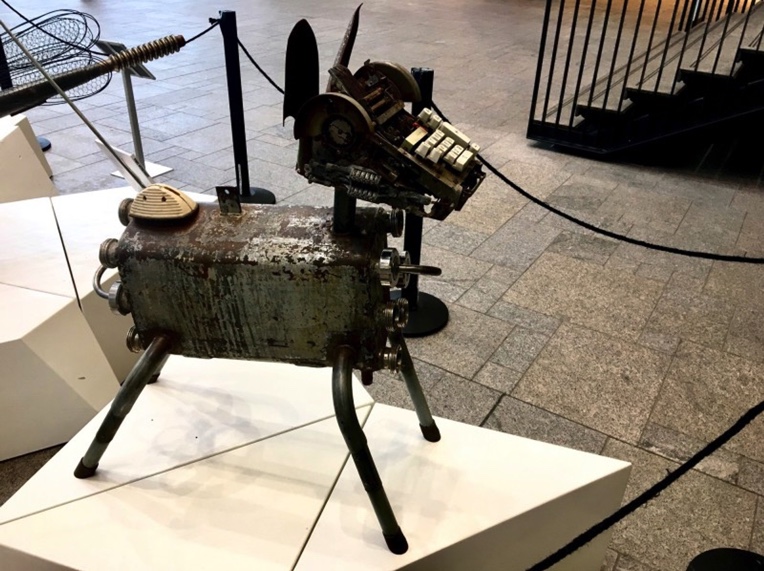Seminar Blogs
Laika Phone Home: Translating the Concept of “Postmemory” to Robotic Theatre – Olga Efremova

In the fourth installment of Transmission in Motion 2021-22 seminar series “Dramaturgy for Devices”, Maaike Bleeker and Marco Rozendaal invited us to analyze four dramaturgical concepts of mise-en-scène, performativity, presence and address (Utrecht University 2022). Reflecting as a part of the discussion on the previous seminars in the series made me wonder about the possible connection between the images of athletic bodies in 1930s totalitarian propaganda films, the ghostly phantasmagorias of precinematic projection theatre, and grainy black and white robot videos that served as focal points of the workshop debate. To understand this connection, I suggest considering what cultural theorist Mieke Bal (2004) called “cultural memory”: the interdisciplinary field where the idea expressed in the phrase “pictorial narrative” is so pervasive that it is not even mentioned, only practiced” (1291).
The dramaturgy for the posthuman theatre, I would argue, begins with a still, two-dimensional narrative of relations that is “replete with ideological and political meaning” (1290). I see evidence for Bal’s argument that “political agency requires imagery to be able to tell stories, this is because the official political authorities rely on linguistic narrative to instill the “proper” stories in their citizens.” (Bal 2004, 1290). The “cultural memory” of the dramaturgy for devices is an affective memory of what is first expressed through pictorial narratives that precede, both in film and theatre, the production of the performance itself. The resistive nature of visual storytelling employed by both film and theatre works as a transgenerational device to pass on the stories that would likely be silenced, censored and stamped out if narrated otherwise.
In her “Figuration” essay, Bal further develops the concept of “cultural memory by linking it to the work of Marianne Hirsch who “develops the concept of postmemory to describe memories, often visual ones, transmitted by parents to children, who conceive of the stories as their own memories, both narrativity and visuality are key to the memories’ functioning.” (Bal 2004, 1291). Postmemory is also the ability to make instant affective connections between past and present, one’s roots and one’s location, placing one’s personal story in the mise-en-scène of “the forms that sociability and subjectivity take” (1290). I have chosen to illustrate this concept with Pinky Messchaaert’s circular art installation displayed in Gemeente Utrecht’s lobby (2022), to which I have given an imaginary title “Laika Phone Home” as an allusion to both the iconic Steven Spielberg’s film E.T. and to the first traveller to space that happened to belong to Haraway’s “companion species” (2016). A defunct 1970s punch button telephone Messchaaert has embedded into the creature head has triggered the “cultural memory” of using a similar device in my childhood, evoking strong feelings of longing for the times and places forever gone. Could there be the key to the political storytelling power of robotic theatre performances? Employing postmemory as a dramaturgical device, they forge similarly strong affective connections that break through space and time to take one, in a single momentary instant, home.
References
Bal, Mieke. 2004. “Figuration.” PMLA/Publications of the Modern Language Association of America 119 (5). Cambridge University Press: 1289–92. doi:10.1632/003081204X17851.
Haraway, Donna J. 2016. Manifestly Haraway. Minneapolis: University of Minnesota Press. Accessed February 3, 2022. ProQuest Ebook Central.
Utrecht University. 2022. “Dramaturgy for Devices” – Maaike Bleeker (UU) and Marco Rozendaal (TU Delft). Transmission in Motion. Accessed February 3, 2022. https://transmissioninmotion.sites.uu.nl/dramaturgy-for-devices-maaike-bleeker-uu-en-marco-roozendaal-tu-delf.
Image:
Pinky Messchaert. 2018. “iDog”. Photographed by Olga Efremova on February 2, 2022 at the artwork installation in Gemeent Utrecht. Digital image. Private collection.

